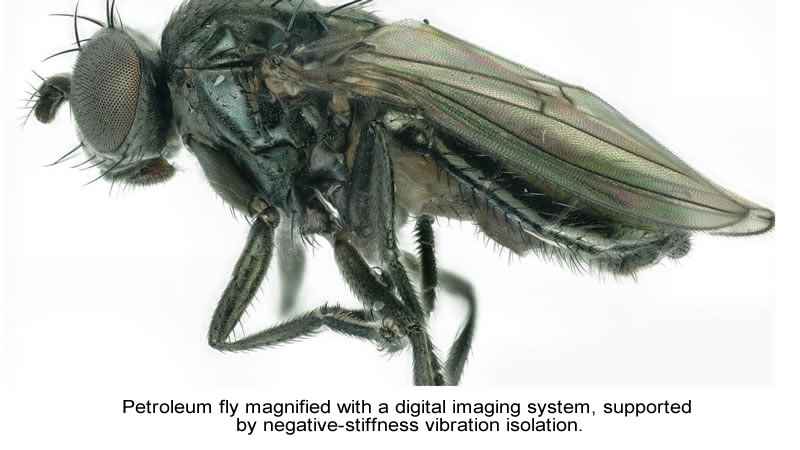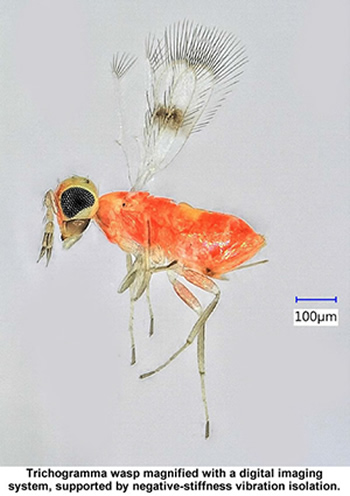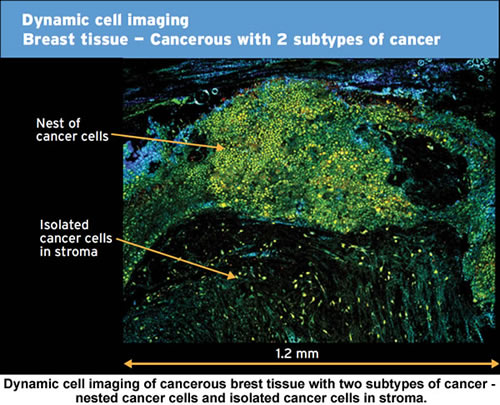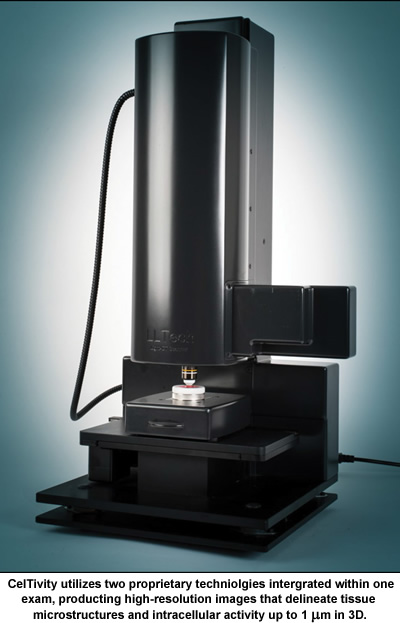|
|
Newsletter September 2023 | Menu of Newsletters
| |
|


Vibration
Isolation Improves Specimen Examination at the
Natural History Museums of
Los Angeles County
The museums'
microscope is supported by negative-stiffness vibration isolation, which
enables precise clarity of specimens being viewed at high magnification and
high resolution
|
The Natural History Museums of Los Angeles County
(NHMLAC), which include the Natural History Museum in Los Angeles' Exposition
Park, the La Brea Tar Pits, and the William S. Harding Museum, is the largest
natural and historical museum in the western United States, holding one of the
world’s most extensive and valuable collections of natural and cultural
history—more than 35 million specimens and artifacts covering 4.5 billion
years of history.
The NHMLAC collections are strong in many fields, but
the mineralogy and Pleistocene paleontology collections are among the most
impressive, the latter thanks to the wealth of specimens collected from the La
Brea Tar Pits located in the heart of Los Angeles. The worlds most powerful
gateway to the Ice Age, the asphalt seeps at the La Brea Tar Pits represent the
only active urban fossil dig site in the world. The site contributes an ongoing
wealth of extraordinary specimens, like saber-toothed cats, mammoths, dire
wolves, and mastodons, as well as the tiny microfossils of insects, plants,
mammals, and reptiles from the last 50,000 years. |
 |
Fundamental to the activities of NHMLAC is
research. Essentially, close examination of these objects, artifacts, and
specimens for the purposes of illustration, preparation of scientific papers
for publishing, and photography for displays within the museum. Much of this
research is conducted with the use of microscopy, viewing specimens at high
magnification and high resolution to observe and examine fine
details.
Researchers at the Natural History Museum in Exposition Park,
for example, are examining the structure of prehistoric fish teeth, minerals,
insects, and other small creatures, said Brian Brown, PhD, curator of the
Entomology Section. Even ancient feathers from 100 million years ago encased in
amber. Amber influences clarity and distorts and changes the viewability of the
feathers. Very high microscopy resolution is needed to examine minute, fine
details from these and other specimens..
|
|
For the examination of its specimens, the museum uses
a digital microscope.
Digital microscopes incorporate observation, image
capture, and measurement capabilities while providing an on-screen interface
for viewing objects. Compared to conventional optical microscopes, digital
microscopy provides superior imaging capabilities. Even at higher
magnification, images are fully focused due to a large, depth- of-field
composition function.
The digital imaging system gives us up to 1,000
times magnification, continued Brown. The microscope allows us to view great
detail and fidelity in our specimens.
Vibration problem
For
several years ambient vibrations severely plagued the microscopes ability to
deliver precision images.
At high magnifications things get very
sensitive, added Brown. This requires great stability. But our microscope is
located on the third floor of the Entomology Section in the museum, in a
cantilevered room extending from the main building. An elevator is located
right next to the room, so we were constantly dealing with vibration issues
that were affecting the quality of our images. We would wait for periods of
relative stability, like between elevator movement, to view images. Even if the
elevator was not running, we would still get ambient vibrations from people
walking around in the department.
Vibration can be caused by a multitude
of factors within a building. Every structure is transmitting noise. Within the
building itself the heating and ventilation system, fans, pumps, compressors,
elevators, doors closing, and footfall are just some of the sources that create
low-frequency vibration that will affect microscopy imaging and data sets.
Depending on how far away the microscopy instrumentation is from these
vibration sources, and where in the structure the instrumentation is
locatedwhether in a basement or in a cantilevered roomwill determine how
strongly the instrumentation will be influenced.
External to the
building, sensitive instrumentation can be influenced by vibrations from truck
movement, road traffic, nearby construction, loud noise from aircraft, and even
wind and other weather conditions that can cause movement of the
structure.
Essentially, we were getting so-so results from the
microscope, and we knew the problem was coming from the ambient vibrations in
the room, explained Brown. We tested an active cancellation vibration isolation
system, but found it hard to set up, and it really did not cancel vibrations
very well. We then did a demonstration of a negative- stiffness passive
vibration isolation system and found it to perform very well.
Article
continued...
|
|
|
|
| |
|

|
Announcing
the 2024 Minus K Technology Educational Giveaway to
U.S. Colleges and
Universities
Minus K
Technology, Inc. is giving away $25,000* worth of patented vibration
isolators to colleges within the United States.
Your college could
receive one of our superior performing negative-stiffness low-frequency
vibration isolators, which use no air or electricity and are currently being
used for biology, neuroscience, chemistry, crystal growing, physics, audio
reproduction and many other fields.
If you have an Atomic Force
Microscope (AFM), Electron Microscope, Interferometer, Laser Optical System,
Micro Hardness Tester, or any other special equipment that would be assisted by
our vibration isolation, simply complete the giveaway submission form and send
it back to
edgiveaway@minusk.com.
If you're one of the top applicants, we'll send you one of these free vibration
isolators to assist you with your research.
Submission deadline
for applications is February 29, 2024. More...
|
|
|
|
|

Fighting Cancer with CelTivity & Interferometer
Vibration Isolation

Inadequate real-time
tissue assessment of biopsies from different cell types, like cancer cells,
immune cells, granuloma, and others, forces proceduralists, such as
bronchoscopists and radiologists, to choose between intraprocedural partial
tissue adequacy assessment, rapid on-site evaluation (ROSE), or sending tissue
samples for full pathology review. Neither truly answers the question, “Do
we have enough cells to submit to pathology for the best chance of a conclusive
diagnosis?” This can lead to prolonged delay for patient results, the need
for a redo procedure, and potential delays for treatment options for the
patient.
Consider lung biopsies, which are excised from patients and
then sent to the laboratory for advanced cancer testing. These tests require
that patients have an adequate amount of high-quality tissue to conduct
advanced tests such as EGFR, kRas, or PD-1/PDL-1. To collect these biopsies,
transthoracic needle biopsy (TTNA) is commonly used, which requires a needle to
be inserted through the chest wall from outside the body. The risk of a
collapsed lung (pneumothorax) can result in an average of 20 percent of
procedures. Navigational bronchoscopy has emerged as a technology to collect
lung biopsies with a lower risk of complications.
A better solution
would be to assess tissue adequacy intra-procedurally, to interrogate and image
the biopsy in its entirety, to determine: Do we have the tissue? What exactly
are we looking at (cancer cells, immune cells, granuloma)? And, do we have
enough cells to submit to pathology to gain the best chance of a conclusive
diagnosis? The results would allow clinicians intraprocedural identification
and interpretation to properly assess tissue samples for adequacy.

....
Vibration
Isolation
Because CelTivitys technologies function at the micron level,
vibration isolation is critical to maintaining the systems highest level of
operation, explaiins Le Conte de Poly. Footfall from someone walking by, the
closing of doors, HVAC units operating, or elevators in motion create
low-frequency vibrations that can influence FFOCT and DCI
imaging.
Consequently, Celtivity is supported by vibration isolation
designed to more thoroughly cancel out low-frequency vibrations, says Le Conte
de Poly. For this purpose, negative-stiffness vibration isolation was selected
because of its high-performance capability, and ease of adaptability to
hospital and laboratory environments.
Full
article...
|
|
|

 |
|
|
